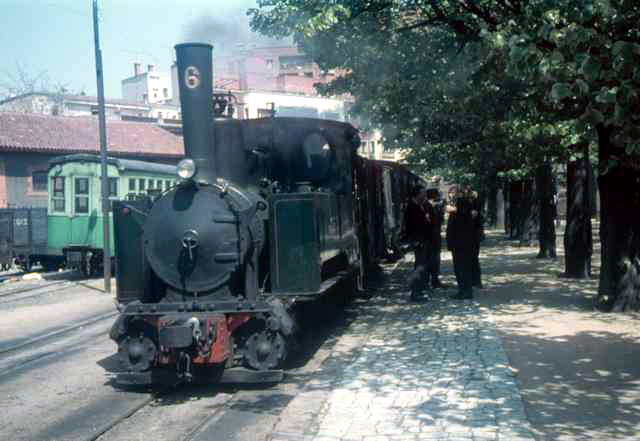 |
Gerona station:
Here we can see the station lanes on a sunny day. One may think that the train was right in the middle of the street since the lanes look so much like your everyday street. On the left ya can see the locomotive depot,oriented in a strange way closing the yard that was between the loading docks and the train station.
Picture taken by Charles F. Firminger (20 april, 1968)
|
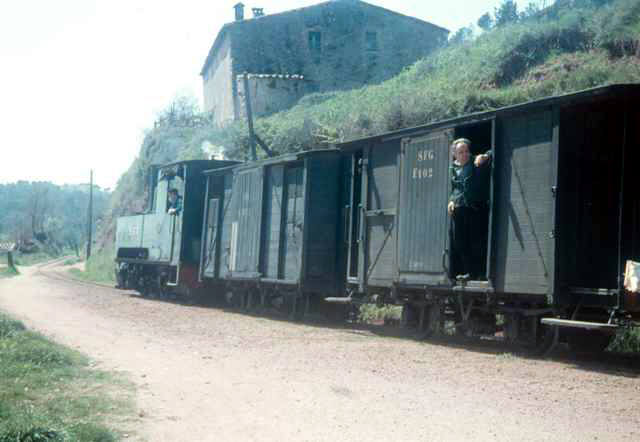 |
The Creueta halt:
A view of the train in which one can view the comercial cars closed. The very first one is a M model car and the second one is a F model. Due to being so close to Gerona (3km), the creueta zone only had a little space for an additional few buildings, including a typical Catalan farmhouse that you can see on the top right of the picture. It is actually called "Can Maige"
Picture taken by Charles F. Firminger (20 april, 1968)
|
|
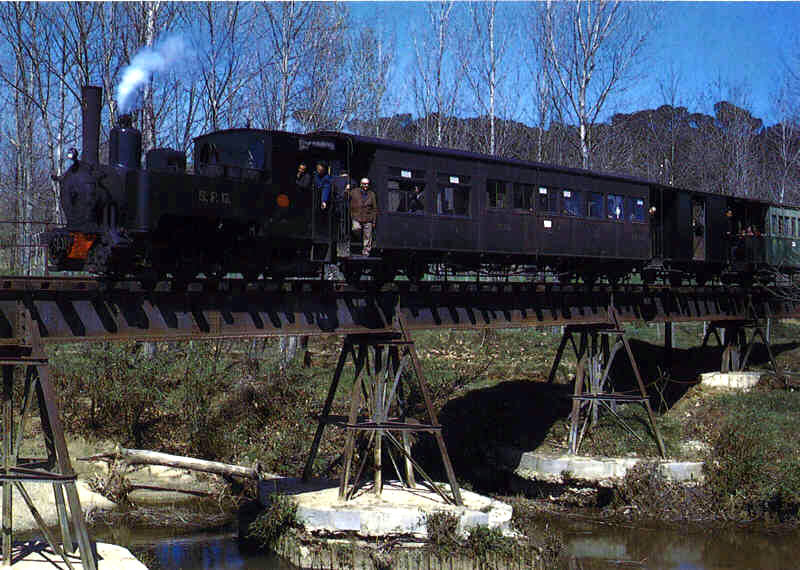
|
Onyar river bridge:
The nº5 locomotive carries a train over the Onyar river.
The metallic bridge can be seen along with its metallic pilars, strongly attached to their corresponding concrete blocks.
In fact, most of the bridges had the same structure, with a single slightly protected lane for the pedestrians to pass by.
Picture taken by Jaume Morell
|
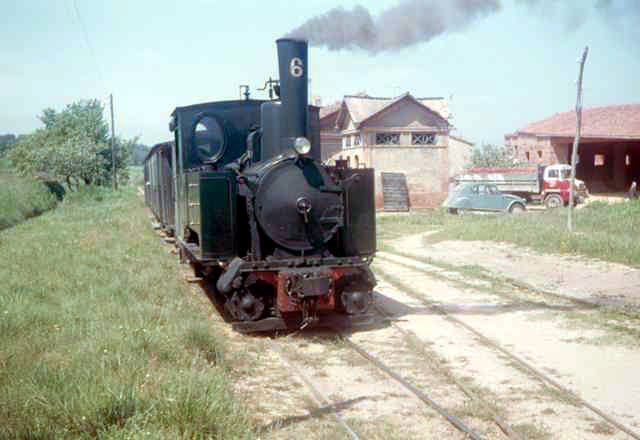 |
Quart station:
6 km away from Gerona lies the Quart station. There in Quart d'Onyar, the town is recognised by its close cities due to Quart's hand made clay utils. But as time went on, Quarts diversified its economy with the installment of a few totally new industries that would pretty much need the train station to operate.
Picture taken by Charles F. Firminger, on April the 20th, 1968
|
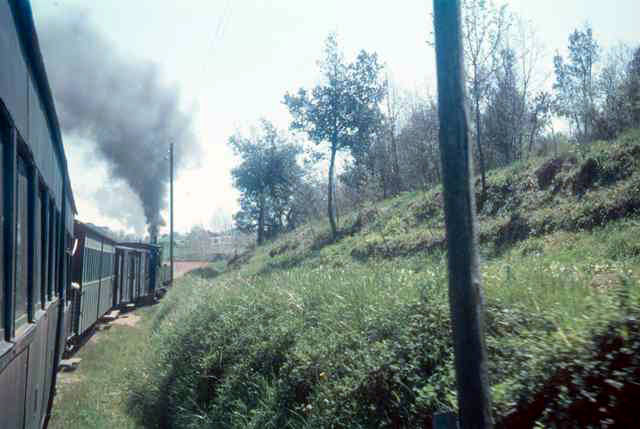 |
Between Quart and Llambilles:
There's one single train from Gerona that makes its way through the flat zone "Riberas de l'Onyar", that leads to Lambillas. One may appreciate the amount of smoke coming out of the locomotive, which indicates how much effort the machine is actually putting on getting up that 0,0018m ramp.
Picture taken by Charles F. Firminger, on April the 20th, 1968
|
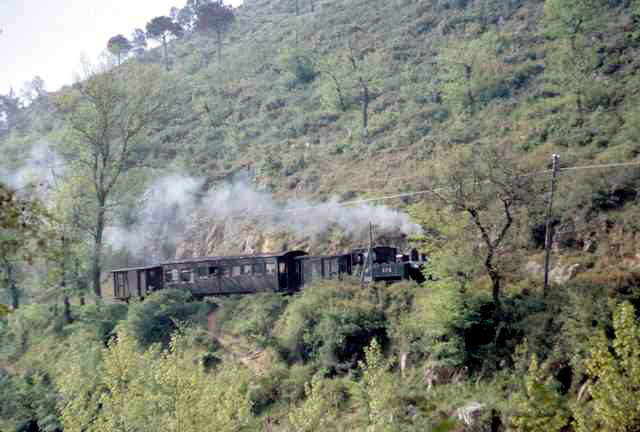 |
On the way to Llambilles:
Right inbetween of Quart and Lambillas the locomotive encounters a 0,0019m ramp. It is the strongest bit of the "Erols" route, and it leads to the Bugantó river valley.
Picture taken by James J. Jarvis, on April the 29th, 1967
|
 |
The Quart ramp:
J. Jarvis took this picture from the Carmen street on Gerona, near the Montilivi neighborhood, that can be seen on the top of the picture. There was a slight curve where the people would get prepared before catching the train while on movement!
Picture taken by James J. Jarvis, on April the 29th, 1967
|
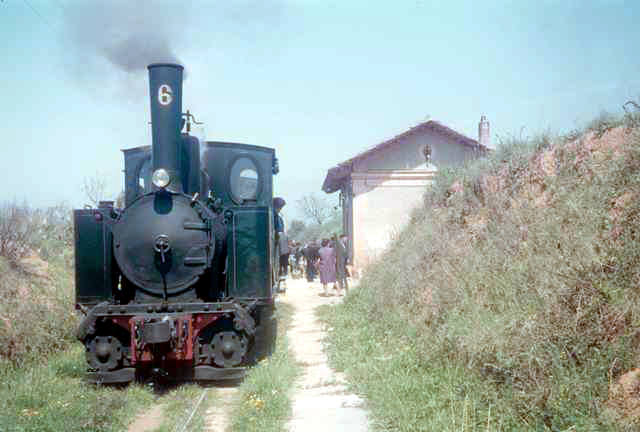 |
Llambillas halt:
8,5 kilometers from Gerona was the stop of Llambillas. Something far from the town congregated around the St. Christopher church.
The town, dedicated to work of the field was losing population throunghout the years, making that the stoppage was used scarcely for the transit of merchandise.
Picture taken by Charles F. Firminger, on April 20th, 1968
|
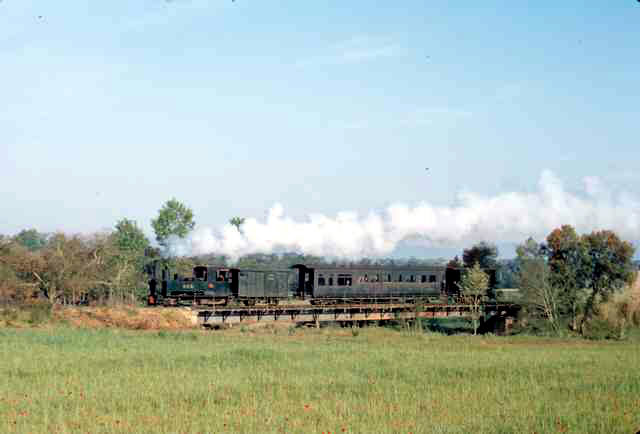 |
Bridge over the Bugantó river:
The bridge over the Bugantó River is located 9.9 kilometers fron Gerona. The bridges of the line were made with pieces of 10 meters, so in this case this bridge of 30 meters over the river Bugantó has three metallic pieces leaning on two pillars.
In this photo is the number 5 locomotive that crosses it with destiny to Gerona.
Picture taken by James J. Jarvis, on April 29th, 1967
|
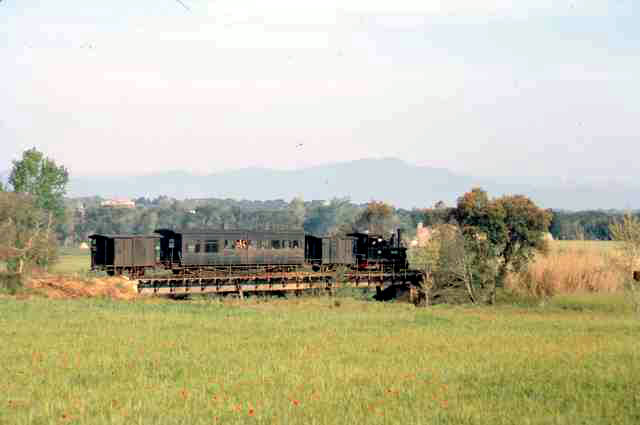 |
Bridge over the Bugantó river:
The photographer waited for the train to pass in the opposite direction on the same bridge, so he could verify that the locomotive number 6 dragged the same train to San Feliu.
From here the train enters a trench, at the end of which was Llebrers halt.
Picture taken by James J. Jarvis, on April 29th, 1967
|
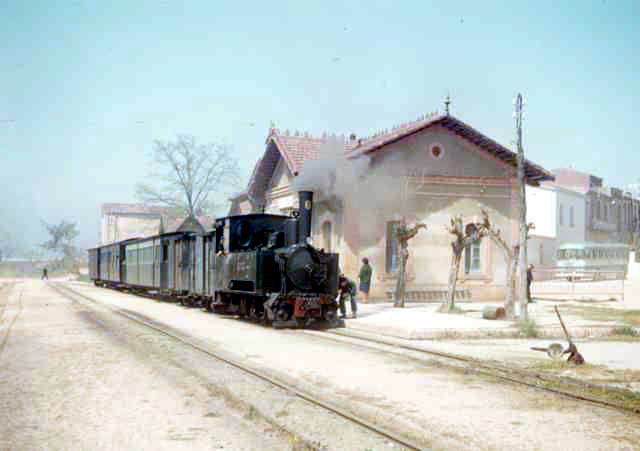 |
Cassà de la Selva station:
At 13,5 kilometers from Gerona was the station of Cassà de la Selva. From 1650, year in which the black plague struck Catalonia, a new office began to be forged in Cassà, the one of stopper.
In this town were manufactured all series of elaborate cork, especially the corks were highly prized by French winemakers.
Picture taken by Charles F. Firminger,on April 20th, 1968
|
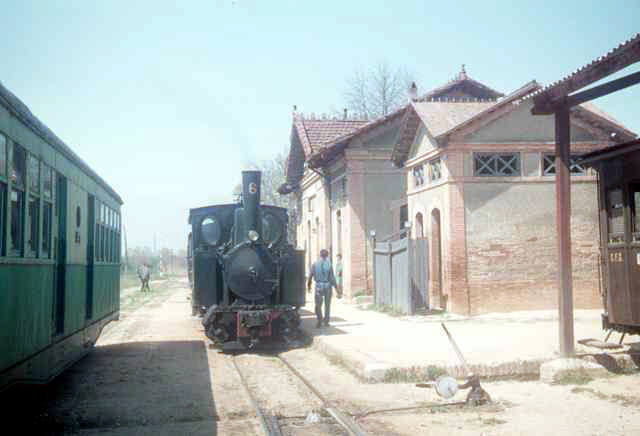 |
Llagostera station:
At 21 kilometers from Gerona was the Llagostera station. Llagostera, formerly protected by its castle, was an important crossroad between the interior regions and the coast.
From here begins the massif of Gavarres, a place populated by oaks and cork oaks, which gave a life to the small train of San Feliu for the transport of plates, corks and made from cork pieces.
Picture taken by Charles F. Firminger, on April 20th, 1968
|
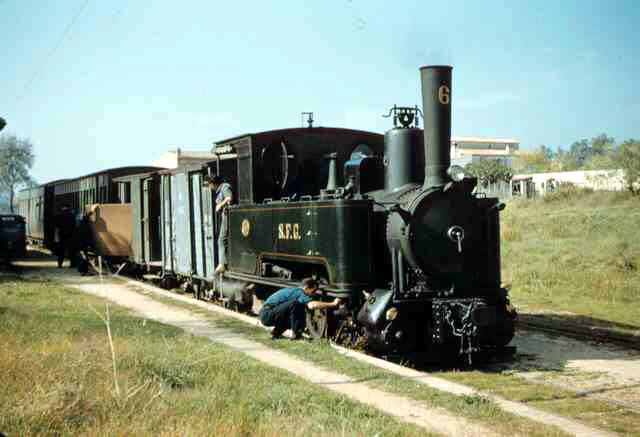 |
Santa Cristina station:
At 32 kilometers from Gerona ther was the Santa Cristina d'Aro station. Since the train enters the Vall d'Aro (name with which the river Ridaura valley is known), it passes by the stop of Font Picant (famous for being a place of excursion and for having a well-known source of thermal water) and slowly descend to Santa Cristina d'Aro.
At the entrance of the station ther was a level crossing with the Palamós route, quite busy in recent times due to turism.
Picture taken by James J. Jarvis, on April 29th, 1967
|
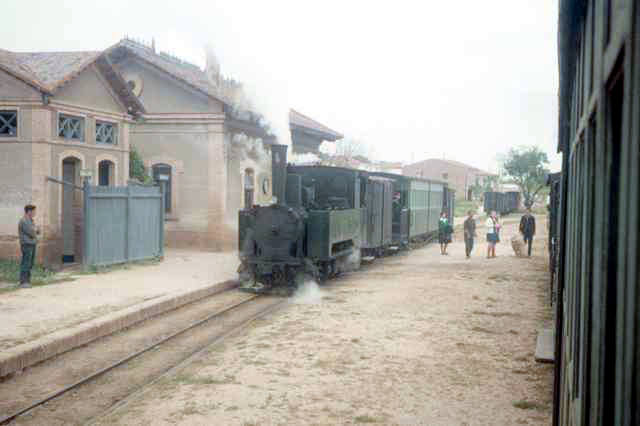 |
Castell d'Aro station:
At 34 kilometers from Gerona there was the Castell d'Aro station. The Benedormiens castle was the begining of this town in the middle ages, which was growing around it.
Castell d'Aro was always a town of traditions, so it prides itself on having preserved the oldest living nativity scene in Catalonia and a medieval market.
Picture taken by Charles F. Firminger, on April 20th, 1968
|
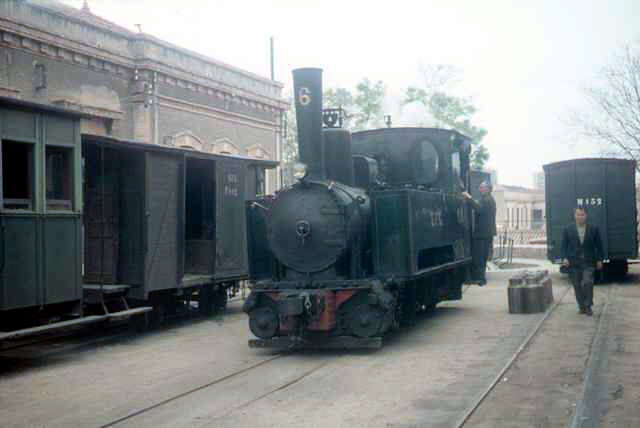 |
San Feliu de Guixols station:
At 39 kilometers from Gerona was the station of Sant Feliu de Guísols. Bey train, it came in by the lift from s'Agaró halt parallel to the sea line. About 400 meters before reaching the station the branch was separated to the port of Sant Feliu de Guísols, the line turned to the north by the margin of the small river and goes up a shot stretch, by means of a left turn crosses the small river and It enters to the center of Sant Feliu.
In a wide esplanade, the workshops, loading docks and the station are built, as close as possible to the historic center of San Feliu.
Picture taken by Charles F. Firminger, on April 20th, 1968
|
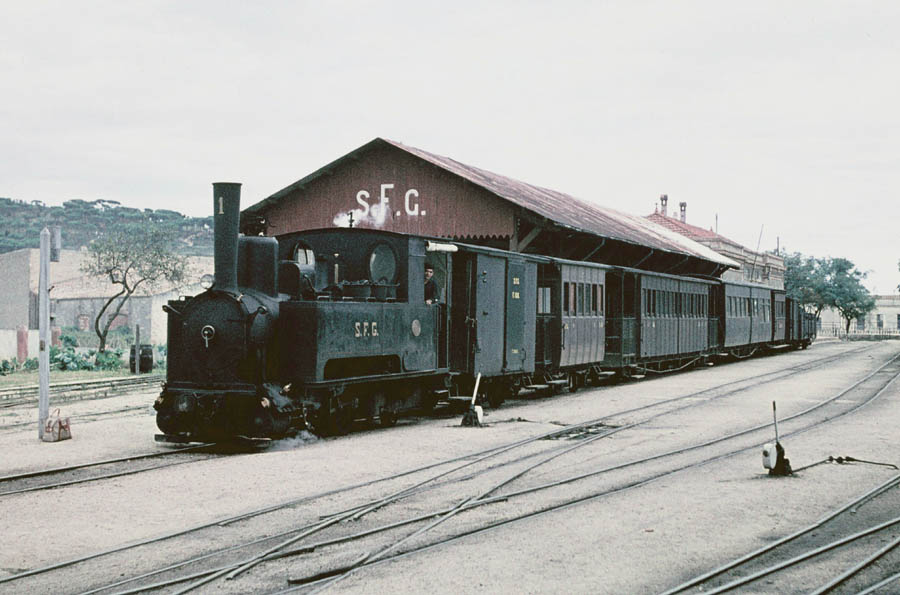 |
San Feliu de Guíxols station:
Train running back to Gerona with locomotive number 1 in front. It can be seen that two-axle wagons were still used the compositions in the early 1960s.
For a small setback that had the autor of the photo, to which the car was damaged, had to go by train to Gerona.
Picture taken by John Carter on 1960
|















